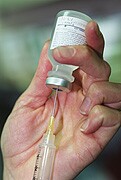
TUESDAY, Nov. 11, 2014 (HealthDay News) — Getting a tetanus-diphtheria-pertussis (Tdap) vaccine during the last trimester of pregnancy is safe for the fetus, a new study has found.
The Tdap vaccine doesn’t increase an expecting mothers’ risk of preterm delivery, low birth weight newborns, or the serious pregnancy complication known as preeclampsia, said lead author Dr. Elyse Kharbanda of the HealthPartners Institute for Education and Research in Minneapolis, Minn.
“The vaccine is the best option we have right now to prevent pertussis in newborns, and our study supports vaccinating women during pregnancy,” Kharbanda said.
Pregnant women are urged to get the Tdap inoculation to provide protection against pertussis, also called whooping cough, during the first two months of their newborn’s life.
When pregnant women receive the vaccine between 27 and 36 weeks’ gestation, they produce antibodies against whooping cough that pass to their unborn children, Kharbanda said.
Babies cannot be vaccinated against whooping cough until they are 2 months old, and during that period the antibodies they’ve inherited from their mother are their only defense against the potentially deadly bacteria, according to the U.S. Centers for Disease Control and Prevention (CDC).
In 2011, the CDC recommended Tdap vaccination for all pregnant women, a year after the state of California made the same recommendation in the wake of a widespread whooping cough outbreak, the study’s authors said in background material.
During 2012, almost 50,000 cases of whooping cough were reported to the CDC, including 20 whooping cough-related deaths that mostly occurred among infants younger than 3 months. This was the most reported cases since 1955, and the incidence rate among infants exceeded that of all other age groups, according to the CDC.
To assess the safety of the Tdap vaccine in pregnancy, researchers gathered data on more than 123,000 women with pregnancies ending in a live birth between 2010 and 2012. Of those women, about one of every five received the Tdap vaccine during pregnancy.
Preterm delivery rates did not vary dramatically between the vaccinated and unvaccinated, nor did the rate of babies born with low birth weight, according to the study.
The researchers reported that among all pregnancies, 8.4 percent who received Tdap during pregnancy and 8.3 percent who were not vaccinated had a baby with low birth weight. The rate of preterm delivery among women receiving Tdap during pregnancy at 36 weeks or earlier was 6.3 percent, whereas the rate for unvaccinated women was 7.8 percent, the study found.
The vaccine also did not significantly increase the women’s risk of preeclampsia or any other diseases linked to high blood pressure during pregnancy, Kharbanda said.
The study did find that pregnant women who got the Tdap vaccination had a slightly increased risk of inflammation of the fetal membranes caused by bacterial infection, a condition called chorioamnionitis (6.1 percent in vaccinated versus 5.5 percent in unvaccinated women).
However, the inflammation didn’t appear to cause an increased number of premature deliveries, which is the major threat posed by chorioamnionitis during pregnancy, Kharbanda said.
The new findings support earlier research that determined the Tdap vaccine is safe when administered during pregnancy, said Dr. Laura Riley, director of labor and delivery for Massachusetts General Hospital in Boston.
Riley, who was not involved with the study, noted that Tdap is not a live vaccine, so babies can’t develop whooping cough from the vaccine itself.
“The people in England, they instituted this same policy and it led to a dramatic decrease in pertussis cases and deaths in newborns,” Riley said. “The U.S. hasn’t done as well in implementation as they did in the U.K., but we’re working on it,” she added.
Both Riley and Kharbanda said that all pregnant women should get the vaccine, and that they should receive a separate Tdap inoculation during each individual pregnancy.
“Studies have shown your antibody response starts to decrease with time, and there may not be quite enough protection left for the next baby,” Riley said.
The findings are published in the Nov. 12 issue of the Journal of the American Medical Association.
More information
For more about whooping cough, visit the U.S. Centers for Disease Control and Prevention.
Copyright © 2025 HealthDay. All rights reserved.

